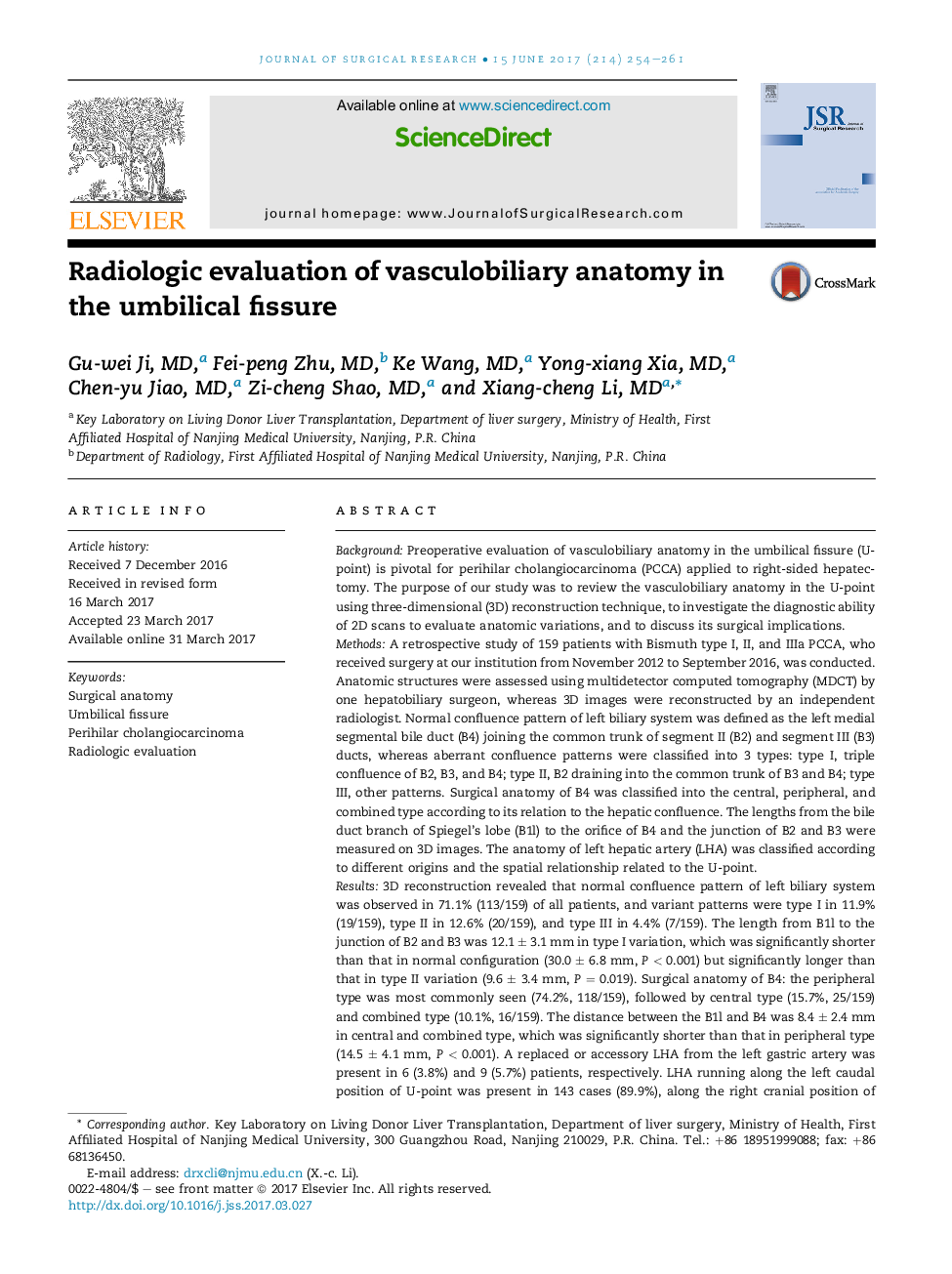| کد مقاله | کد نشریه | سال انتشار | مقاله انگلیسی | نسخه تمام متن |
|---|---|---|---|---|
| 5733774 | 1612518 | 2017 | 8 صفحه PDF | دانلود رایگان |
BackgroundPreoperative evaluation of vasculobiliary anatomy in the umbilical fissure (U-point) is pivotal for perihilar cholangiocarcinoma (PCCA) applied to right-sided hepatectomy. The purpose of our study was to review the vasculobiliary anatomy in the U-point using three-dimensional (3D) reconstruction technique, to investigate the diagnostic ability of 2D scans to evaluate anatomic variations, and to discuss its surgical implications.MethodsA retrospective study of 159 patients with Bismuth type I, II, and IIIa PCCA, who received surgery at our institution from November 2012 to September 2016, was conducted. Anatomic structures were assessed using multidetector computed tomography (MDCT) by one hepatobiliary surgeon, whereas 3D images were reconstructed by an independent radiologist. Normal confluence pattern of left biliary system was defined as the left medial segmental bile duct (B4) joining the common trunk of segment II (B2) and segment III (B3) ducts, whereas aberrant confluence patterns were classified into 3 types: type I, triple confluence of B2, B3, and B4; type II, B2 draining into the common trunk of B3 and B4; type III, other patterns. Surgical anatomy of B4 was classified into the central, peripheral, and combined type according to its relation to the hepatic confluence. The lengths from the bile duct branch of Spiegel's lobe (B1l) to the orifice of B4 and the junction of B2 and B3 were measured on 3D images. The anatomy of left hepatic artery (LHA) was classified according to different origins and the spatial relationship related to the U-point.Results3D reconstruction revealed that normal confluence pattern of left biliary system was observed in 71.1% (113/159) of all patients, and variant patterns were type I in 11.9% (19/159), type II in 12.6% (20/159), and type III in 4.4% (7/159). The length from B1l to the junction of B2 and B3 was 12.1 ± 3.1 mm in type I variation, which was significantly shorter than that in normal configuration (30.0 ± 6.8 mm, P < 0.001) but significantly longer than that in type II variation (9.6 ± 3.4 mm, P = 0.019). Surgical anatomy of B4: the peripheral type was most commonly seen (74.2%, 118/159), followed by central type (15.7%, 25/159) and combined type (10.1%, 16/159). The distance between the B1l and B4 was 8.4 ± 2.4 mm in central and combined type, which was significantly shorter than that in peripheral type (14.5 ± 4.1 mm, P < 0.001). A replaced or accessory LHA from the left gastric artery was present in 6 (3.8%) and 9 (5.7%) patients, respectively. LHA running along the left caudal position of U-point was present in 143 cases (89.9%), along the right cranial position of U-point in nine cases (5.7 %), and combined position in seven cases (4.4%). Interobserver agreement of two imaging modalities was almost perfect in biliary confluence pattern (kappa = 0.90; 95% confidence interval: 0.79-1.00), substantial in surgical anatomy of B4 (kappa = 0.74; 95% confidence interval: 0.62-0.86), and perfect in LHA (kappa = 1.00).ConclusionsThoroughly understanding the imaging characters of surgical anatomy in the U-point may be benefit for preoperative evaluation of PCCA by successive review of 2D images alone, whereas 3D reconstruction technique allows detailed hepatic anatomy and individualized surgical planning for advanced cases.
Journal: Journal of Surgical Research - Volume 214, 15 June 2017, Pages 254-261
